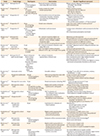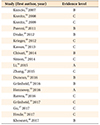1. Fujiyama K, Honjo T, Suzuki M, Matsuoka S, Deguchi T. Analysis of pain level in cases treated with Invisalign aligner: comparison with fixed edgewise appliance therapy. Prog Orthod. 2014; 15:64.

2. Azaripour A, Weusmann J, Mahmoodi B, Peppas D, Gerhold-Ay A, Van Noorden CJ, et al. Braces versus Invisalign®: gingival parameters and patient's satisfaction during treatment: a cross-sectional study. BMC Oral Health. 2015; 15:69.

3. White DW, Julien KC, Jacob H, Campbell PM, Buschang PH. Discomfort associated with Invisalign and traditional brackets: a randomized, prospective trial. Angle Orthod. 2017; 87:801–808.

4. Proffit WR, Fields HW, Sarver DM. Ortodontia contemporánea. 5th ed. Barcelona: Elsevier Mosby;2013.
5. Kesling HD. The philosophy of tooth positioning appliance. Am J Orthod. 1945; 31:297–304.
6. Ponitz RJ. Invisible retainers. Am J Orthod. 1971; 59:266–272.

7. Sheridan JJ, LeDoux W, McMinn R. Essix retainers: fabrication and supervision for permanent retention. J Clin Orthod. 1993; 27:37–45.
8. Bouchez R. Clinical success in Invisalign orthodontic treatment. Paris: Quintessence International;2010.
9. Lagravère MO, Flores-Mir C. The treatment effects of Invisalign orthodontic aligners: a systematic review. J Am Dent Assoc. 2005; 136:1724–1729.
10. Rossini G, Parrini S, Castroflorio T, Deregibus A, Debernardi CL. Efficacy of clear aligners in controlling orthodontic tooth movement: a systematic review. Angle Orthod. 2015; 85:881–889.

11. Rossini G, Parrini S, Castroflorio T, Deregibus A, Debernardi CL. Periodontal health during clear aligners treatment: a systematic review. Eur J Orthod. 2015; 37:539–543.

12. Zheng M, Liu R, Ni Z, Yu Z. Efficiency, effectiveness and treatment stability of clear aligners: a systematic review and meta-analysis. Orthod Craniofac Res. 2017; 20:127–133.

13. Moher D, Liberati A, Tetzlaff J, Altman DG. PRISMA Group. Preferred reporting items for systematic reviews and meta-analyses: the PRISMA statement. PLos Med. 2009; 6:e1000097.

14. Centre for reviews and dissemination. Systematic reviews-CRD's guidance for undertaking reviews in health care. York, UK: University of York;2009.
15. Kravitz ND, Kusnoto B, BeGole E, Obrez A, Agran B. How well does Invisalign work? A prospective clinical study evaluating the efficacy of tooth movement with Invisalign. Am J Orthod Dentofacial Orthop. 2009; 135:27–35.

16. Kassas W, Al-Jewair T, Preston CB, Tabbaa S. Assessment of Invisalign treatment outcomes using ABO model grading system. J World Fed Orthod. 2013; 2:e61–e64.
17. Zhang XJ, He L, Guo HM, Tian J, Bai YX, Li S. Integrated three-dimensional digital assessment of accuracy of anterior tooth movement using clear aligners. Korean J Orthod. 2015; 45:275–281.

18. Ravera S, Castroflorio T, Garino F, Daher S, Cugliari G, Deregibus A. Maxillary molar distalization with aligners in adult patients: a multicenter retrospective study. Prog Orthod. 2016; 17:12.

19. Grünheid T, Loh C, Larson BE. How accurate is Invisalign in nonextraction cases? Are predicted tooth positions achieved? Angle Orthod. 2017; 87:809–815.

20. Alexanderson K, Norlund A. Swedish Council on Technology Assessment in Health Care (SBU). Chapter 2. Methods used for the systematic literature search and for the review of relevance, quality and evidence of studies. Scand J Public Health Suppl. 2004; 63:31–35.
21. Duncan LO, Piedade L, Lekic M, Cunha RS, Wiltshire WA. Changes in mandibular incisor position and arch form resulting from Invisalign correction of crowded dentition treated nonextraction. Angle Orthod. 2016; 86:577–583.

22. Grünheid T, Gaalaas S, Hamdan H, Larson BE. Effect of clear aligner therapy on the buccolingual inclination of mandibular canines and the intercanine distance. Angle Orthod. 2016; 86:10–16.

23. Pavoni C, Lione R, Laganà G, Cozza P. Self-ligating versus Invisalign: analysis of dento-alveolar effects. Ann Stomatol (Roma). 2011; 2:23–27.
24. Kravitz ND, Kusnoto B, Agran B, Viana G. Influence of attachments and interproximal reduction on the accuracy of canine rotation with Invisalign. A prospective clinical study. Angle Orthod. 2008; 78:682–687.

25. Simon M, Keilig L, Schwarze J, Jung BA, Bourauel C. Treatment outcome and efficacy of an aligner technique--regarding incisor torque, premolar derotation and molar distalization. BMC Oral Health. 2014; 14:68.

26. Krieger E, Seiferth J, Marinello I, Jung BA, Wriedt S, Jacobs C, et al. Invisalign® treatment in the anterior region: were the predicted tooth movements achieved? J Orofac Orthop. 2012; 73:365–376.
27. Gu J, Tang JS, Skulski B, Fields HW Jr, Beck FM, Firestone AR, et al. Evaluation of Invisalign treatment effectiveness and efficiency compared with conventional fixed appliances using the Peer assessment rating index. Am J Orthod Dentofacial Orthop. 2017; 151:259–266.

28. Khosravi R, Cohanim B, Hujoel P, Daher S, Neal M, Liu W, et al. Management of overbite with Invisalign appliance. Am J Orthod Dentofacial Orthop. 2017; 151:691–699.e2.
29. Drake CT, McGorray SP, Dolce C, Nair M, Wheeler TT. Orthodontic tooth movement with clear aligners. ISRN Dent. 2012; 2012:657973.

30. Chisari JR, McGorray SP, Nair M, Wheeler TT. Variables affecting orthodontic tooth movement with clear aligners. Am J Orthod Dentofacial Orthop. 2014; 145:4 Suppl. S82–S91.

31. Houle JP, Piedade L, Todescan R Jr, Pinheiro FH. The predictability of transverse changes with Invisalign. Angle Orthod. 2017; 87:19–24.

32. Hennessy J, Garvey T, Al-Awadhi EA. A randomized clinical trial comparing mandibular incisor proclination produced by fixed labial appliances. Angle Orthod. 2016; 86:706–712.

33. Kuncio D, Maganzini A, Shelton C, Freeman K. Invisalign and traditional orthodontic treatment postretention outcomes compared using the American Board of Orthodontics objective grading system. Angle Orthod. 2007; 77:864–869.

34. Li W, Wang S, Zhang Y. The effectiveness of the Invisalign appliance in extraction cases using the ABO model grading system: a multicenter randomized controlled trial. Int J Clin Exp Med. 2015; 8:8276–8282.
35. Akyalcin S, Misner K, English JD, Alexander WG, Alexander JM, Gallerano R. Smile esthetics: evaluation of long-term changes in the transverse dimension. Korean J Orthod. 2017; 47:100–107.

36. Hennessy J, Al-Awadhi EA. Clear aligners generations and orthodontic tooth movement. J Orthod. 2016; 43:68–76.





 PDF
PDF ePub
ePub Citation
Citation Print
Print







 XML Download
XML Download